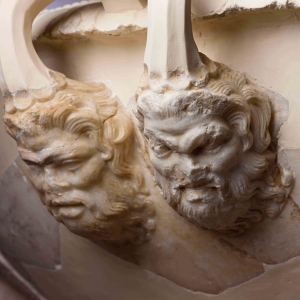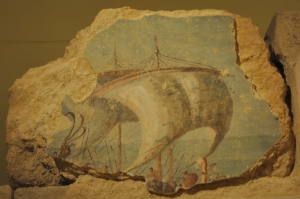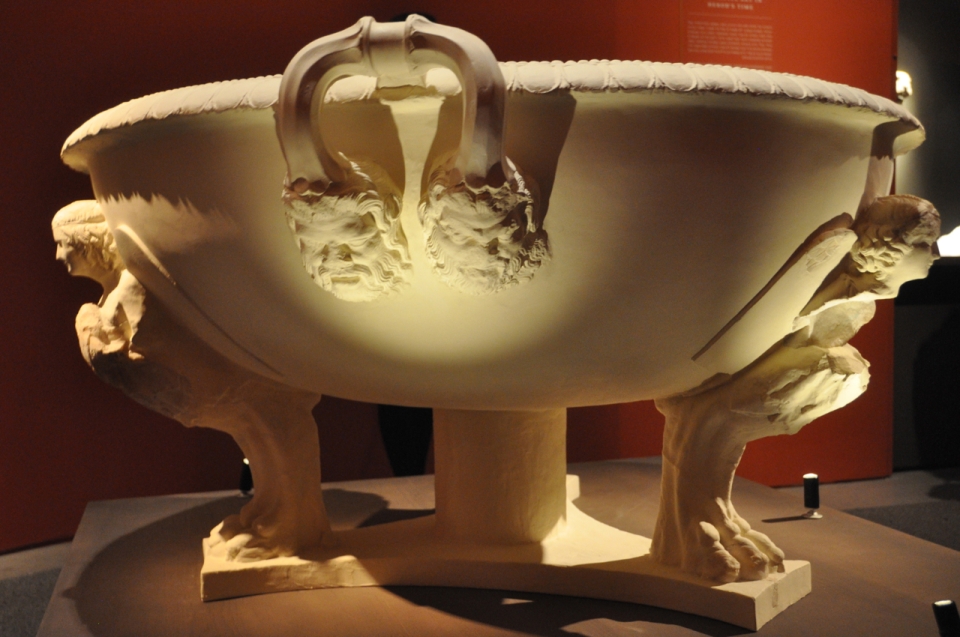The New York Times article reporting on the Herod exhibit at the Israel Museum concludes with my comments.
Shmuel Browns, a tour guide and expert on Herodium who helped Netzer excavate the site as a volunteer, said he was awed by the meticulous reconstruction, particularly of a large basin adorned with several heads that was found in pieces in two disparate places at the site, now an Israeli national park.
“They’ve built things from what was found that you could never imagine from what you saw at the site,” Mr. Browns said. “The message is very, very strong about who Herod is and what he did. He wasn’t intimidated by topography, he wasn’t intimidated by material, he wasn’t intimidated by lack of water.
“He’s a fascinating character,” Mr. Browns added. “He just got very, very bad press.”
 While excavating Lower Herodium, archaeologist Ehud Netzer found marble pieces of a wash basin in the bath-house, including a pair of Silenoi heads – the companion and tutor of the wine god, Dionysos. Conceivably, it was a gift from the Emperor Augustus that his deputy Marcus Agrippa presented to Herod, on his tour of Judea in 15 BCE and installed as a fountain. Imagine this fragile and heavy object making its journey from Greece to Rome to Judea and the bath-house at Herodium. The conservation staff of the museum painstakingly reconstructed the basin with its ornate decoration.
While excavating Lower Herodium, archaeologist Ehud Netzer found marble pieces of a wash basin in the bath-house, including a pair of Silenoi heads – the companion and tutor of the wine god, Dionysos. Conceivably, it was a gift from the Emperor Augustus that his deputy Marcus Agrippa presented to Herod, on his tour of Judea in 15 BCE and installed as a fountain. Imagine this fragile and heavy object making its journey from Greece to Rome to Judea and the bath-house at Herodium. The conservation staff of the museum painstakingly reconstructed the basin with its ornate decoration.
Though it is not known to what degree Herod observed traditional Jewish practices, he appears to have respected them. Aside from this basin, no other human images, in sculptural form, have been found in any of Herod’s palaces.
 When Netzer excavated above the theater at Herodium he found the loggia, the VIP box for Herod and his guests, like Marcus Agrippa. Delicate trompe l’oeil paintings were on the walls, done in secco – painting on dry plaster, a technique unusual for this area. Scenes of nature through a painting of an open-shuttered window, itself a painting hanging on the wall. Dudi Mevorah, one of the curators of the exhibit, pointed out a painting of a boat with billowing sail on plaster from the loggia, alluding to Marcus Agrippa’s history-changing victory over Mark Anthony at the naval battle of Actium. Herod dictated the images in the paintings as a lead-in to the discussions that Herod was interested in having with his guest.
When Netzer excavated above the theater at Herodium he found the loggia, the VIP box for Herod and his guests, like Marcus Agrippa. Delicate trompe l’oeil paintings were on the walls, done in secco – painting on dry plaster, a technique unusual for this area. Scenes of nature through a painting of an open-shuttered window, itself a painting hanging on the wall. Dudi Mevorah, one of the curators of the exhibit, pointed out a painting of a boat with billowing sail on plaster from the loggia, alluding to Marcus Agrippa’s history-changing victory over Mark Anthony at the naval battle of Actium. Herod dictated the images in the paintings as a lead-in to the discussions that Herod was interested in having with his guest.
Herod the Great: The King’s Last Journey is a monumental exhibit that should not be missed. It gives us new insights into the very complex figure that is Herod, his determination not be constrained by nature, topography or materials and his consummate grasp of realpolitik.



Pingback: Herod – Design and Realpolitik | HolyLandPhotos' Blog
Pingback: Herod the Great in the Israel Museum | Ferrell's Travel Blog
Pingback: Israel Roundup | Israel Tours | Israel Tour Guide
Pingback: Israel Roundup | Israel Tours | Israel Tour Guide